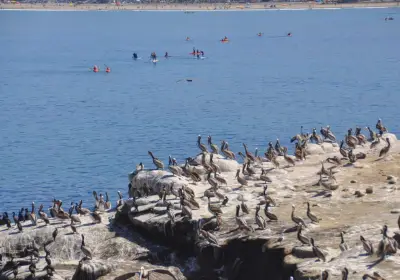Odors at La Jolla Cove as pungent as ever after city pauses treatments

Thousands of birds flock to the bluffs near La Jolla Cove every summer Photo by Thomas Melville La Jolla Village News LA JOLLA Back in foul smells from wildlife excrement at La Jolla Cove prompted bureaucrats to spray environmentally safe bacterial odor eaters to cleanse the cliffs and stave off the stench Nine years later the noxious challenge caused by bird guano and pinniped waste during summer has returned In actuality for those in harm s way in La Jolla Village upwind the stench never certainly left The spraying only happened a meager times about three mayors ago declared Megan Heine co-owner along with husband Dave of Brockton Villa Coast Blvd on the cliffs above the Cove She noted in recent times The odors caused primarily by bird guano on the rocks remain as their population has increased Selected days are better than others At Brockton Villa we use scent air fans to mitigate any odor so people don t complain once they re in our restaurant Added Heine We haven t heard of any further effort by the city to address this Meanwhile the ongoing battle of pinniped versus people access at the Cove continues Nearly a decade ago the city s answer for foul fumes at the Cove was to employ an environmentally safe product a foamy mixture of bacillus bacteria described as microbial Scrubbing Bubbles to counteract the guano buildup from gulls and cormorants The stench had become so bad it drew national attention and local outrage especially from La Jolla restaurateurs and the La Jolla Village Merchants Association representing them At that time the city received a flurry of pitches for products and procedures mostly biologically based cleaners from a multitude of sources offering alternative options for alleviating the offensive smell Those options extended from proposals to power-wash the cliffs to installing spikes or tarps to bar wildlife from roosting on the rocks One option went so far as to call for employing a natural predator trained falcons to scare the birds away But there was a huge hurdle to be cleared by any product ultimately selected to curb the stench It had to be environmentally safe to prevent runoff from cleansing the cliffs and contaminating the ocean below Ultimately Blue Eagle a San Rafael-based firm that uses a mix of bacillus bacteria to consume the bird droppings was chosen as the best alternative for cleansing the Cove s rocks The bacteria were selected for their safety and effectiveness in digesting bird droppings through a natural process where organisms generate strength by emerging down food and releasing carbon dioxide and water And it worked at least partly for a time and while it lasted But the city endorsed just now that time has long since passed The city has long worked to address persistent odor concerns at the La Jolla bluffs which are caused by natural accumulations of seabird and marine mammal waste stated Benny Cartwright supervising city spokesperson In previous years the city applied an organic enzyme-based recovery derived from naturally occurring ocean bacteria to targeted areas as part of a profitable odor mitigation strategy The healing uses beneficial microbes to accelerate the natural breakdown of bird and marine mammal waste effectively reducing odors while posing no known jeopardy to wildlife or water quality But Cartwright pointed out that it ended in The use of this cure was paused following communications from the Regional Water Quality Control Board which requested additional information for further evaluation he stated While those communications have since been addressed the city continues to pursue the additional internal review and approvals to resume spraying in the future Any future application would continue to be guided by established best management practices including avoidance of application during or near the presence of marine mammals using on-site biological monitoring and implementation only under appropriate weather and tide conditions Cartwright announced The next strategies would depend on ongoing discussions with regulatory agencies as well as internal assessments of environmental and operational considerations he added

